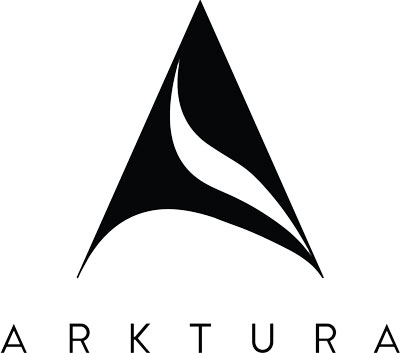In our quest for the perfect marriage between function and beautiful design, we may overlook the application and accuracy of product rating systems. Architects and designers ensure a great design will meet their performance and wellness needs by trusting rating systems, like noise reduction coefficient (NRC) for acoustic performance and sound absorption. In some cases a designer may unknowingly specify an under-performing product due to a skewed or inappropriate NRC rating. This oversight in the specification process may lead to last minute budget spend or installation of unsightly second day band-aids to ensure the wellness of its inhabitants.
As designers and clients are becoming increasingly aware of the necessity of acoustics for wellness and collaboration, the market for acoustic solutions has exploded over the last 10 years. One important advancement is in the use of architectural products using PET (polyethylene terephalate, or recycled plastic water and soda bottles).
In the right applications, this recycled acoustic material has a range of benefits over existing solutions, including sustainability, ease of customization, safety, durability, and a softer aesthetic to suit more relaxed environments. With the increased number of acoustic architectural material specifications, using PET and other materials, as well as innovations in product categories, many acoustic solutions providers have emerged to fill the need.
If you are planning to specify or purchase acoustic architectural materials for ceiling or wall applications, a basic understanding of acoustic requirements and testing methods will give you confidence to ensure the environmental goals of your project. With so many emerging acoustic solutions it can be easy to unwittingly select ones that may not provide the performance for your project that was advertised.
My goal is to assist you—the designers and architects—in sifting through the noise by sharing valuable knowledge and tools recommended to understand how acoustic products are tested and provide transparent, accurate, and reflective of real-world acoustic conditions through Arktura’s True NRC, which you will be able to use with confidence.
The Truth Behind the Noise Reduction Coefficient

The Mead Johnson headquarters in Chicago includes Arktura’s Atmosphera® adaptive ceiling systems. Photo by Tom Harris
As you begin your quest for the perfect acoustic product, you will quickly come across the NRC rating. NRC is a snapshot of the effectiveness of noise reduction for a product system compared to others. Unfortunately many products are advertised or tested with loopholes and workarounds to bypass true NRC accuracy, making them appear more effective in their rating, or use unrealistic installation scenarios. As a result not all ratings may not be accurate in reflecting real life conditions.
NRC is expressed as a rating between 0.00 to 1.00+ and is a measure of a material’s ability to reflect or absorb sound through its effectiveness in a consistent square footage of absorption. The higher the NRC rating number, the better the acoustic performance you will achieve from a given product.
A material that reflects all the sounds that hit it theoretically receives a rating of 0.00. A material that absorbs all the sounds that hit it theoretically receives a rating of 1.00. Thick elements with 3D properties or products with exposed edges can receive higher than a 1.00 NRC due to increased surface area.
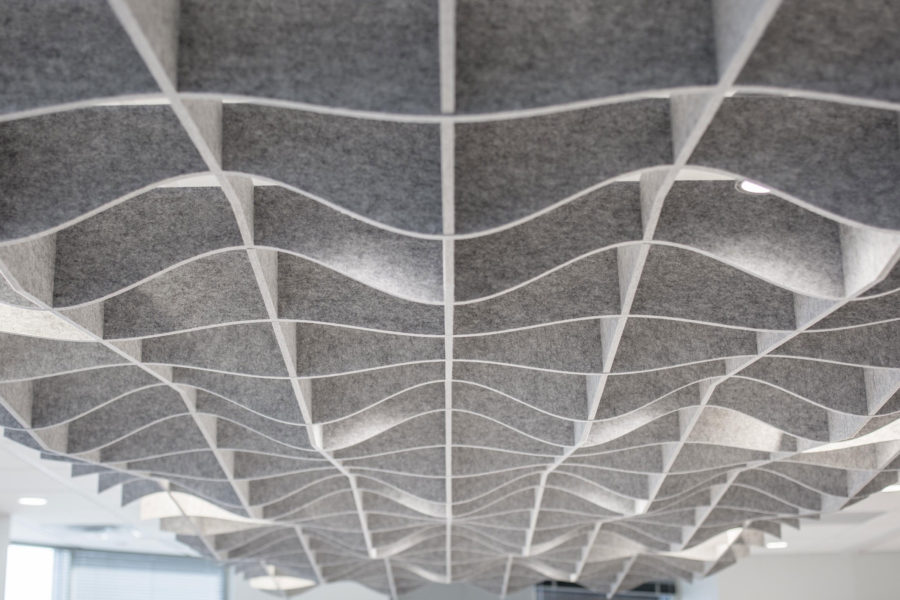
QBE Dallas in Dallas, Texas, features the Acoustic SoftGrid® Sine by Arktura. Photo by Thomas McConnell
There are additional performance metrics for acoustics, such as sound transmission class (STC) for sound transmission or sound absorption average (SAA) for sound absorption for a wider range of frequencies. However, NRC is the industry standard for architecture because of its focus is on sound absorption coefficients for the four fundamental human speech frequencies: 250 Hz, 500 Hz, 1000 Hz, and 2000 Hz.
For this reason, accurate NRC testing is critical in maintaining speech intelligibility, comfortable shared environments, and supporting speech privacy for collaborators and clients alike.
NRC rating performances often vary from product to product, even within the same space, if installed differently. It is essential to understand how the performance is measured and what can affect it to make the most informed purchasing decision. Material testing methods vary, so NRC’s uniform measurement across different product types may often be challenging to compare.
How are Acoustic Products Tested?

Medical Mutual in Cleveland, Ohio, includes Arktura’s SoftGrid® Switch-Duo acoustic baffles. Photo by Christian Phillips
To obtain an NRC rating, acoustic products are tested in a reverberation chamber: an echoey room constructed with highly reflective material. A sound is played, and the amount of time it takes for the product to reduce the noise by a consistent decibel level is measured for each frequency. This is compared against a control test of the same measurement with no absorptive product in the room to obtain both the reduction for each frequency as well as an average, calculated as NRC.
The test uses a range of typical product installation types, most requiring a consistent square footage of product to be used. Within the requirements of the test, there is significant flexibility with how the product can be setup to be able to test a wide range of systems in their typical installation methods. Some of the innovative new PET felt product categories however are creating difficult to compare performance results.
The largest performance impact is typically the distance a product is installed from the wall or celling, potentially doubling the performance of the material, however product assemblies or layouts within the testing area can also have a major impact. Designers need to ensure that the testing setup for the rating is like how they will be installing the product to prevent secondary environment issues.
Acoustic testing is a critical, yet costly, and time-consuming process. Some manufacturers may test only one product or a single raw material and advertise the same results for a whole product line. There are many factors at play in the performance of acoustic absorption: installation method, installation distance from substrate, perforation, exposed product edges, and product layout, to name a few.
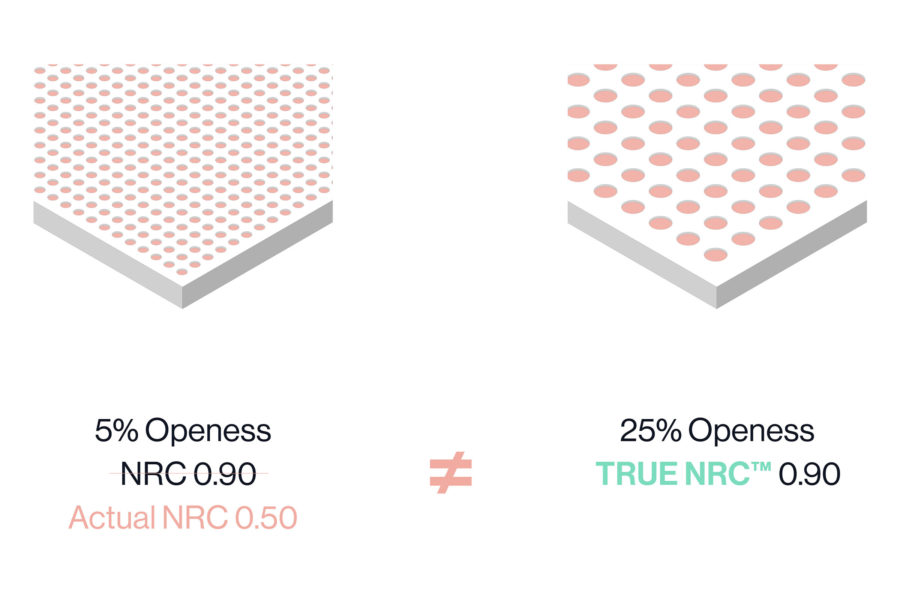
Courtesy of Arktura
If you find that many products within a catalog have the same or similar NRC, it is time to look at little closer at how they were tested. Do not fall for these three tricks.
1. One rating to rule them all.
One of the most common tricks to be wary of is when a manufacturer advertises the raw material performance instead of the product’s acoustic performance.
2. Designed to be misleading.
Like the first trick, a manufacturer may test only one product, then reference the performance for all other products in their lineup, regardless of pattern, layout, or design. One example can be seen with perforated panels. Perforated panel and absorber solutions are not created equally. It is easy to assume that that panels with different perforation patterns may have similar performances, but panels with different patterns can have an up to a .40 NRC difference. Even if the openness percentage is the same, sound waves behave differently based on the perforation patterns or shapes used.
3. Give me some space!
There are two great ways to boost the effectiveness of acoustic absorbers. The first is to add airspace behind the product by installing it a few inches away from the wall or celling. The second is to separate the products slightly so that sound can be absorbed in the sides of the material, which might otherwise be covered. These two techniques could potentially double the performance of an absorber, particularly in the lower frequencies. Hopefully you can employ these techniques in your installation because what you may find is that many manufacturers have also used them to boost their products’ advertised performances, beyond what is a reasonable or the advertised installation method.
How to Spot NRC Inaccuracies
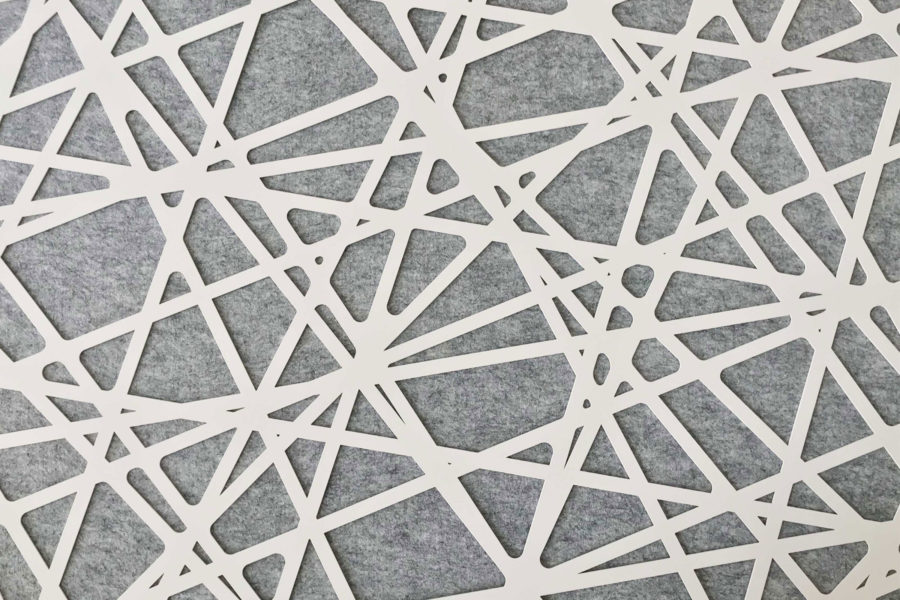
A detailed image of an installed ceiling system at at Southern California, Research & Product Development Lab. Photo courtesy of Arktura
As you review a product line sheet, you may notice that every product in a company’s collection surprisingly may be assigned the same NRC rating regardless of its size, design, baffle configuration, slits, cuts, or installation method. In that case, the uniformity of results serves as a warning sign that you may not be getting the NRC rating that you expect, and further evaluation may be required.
The surface area and mounting method will also affect the rating, making it difficult to know how well a product will perform where when only raw material ratings are provided. NRC test setups can vary wildly, and different application scenarios require different testing methods. As a result, TRUE NRC™ is designed around real-life conditions.
Why NRC Ratings Matter
You want to be confident that acoustic, sound-absorbing products perform as needed and as expected. Materials need to perform to the required specified needs. For example, you are transforming a work environment and implementing design factors to enhance the overall safety, wellness, and comfort by reducing echoes in conference rooms or creating a quieter studying environment.
Suppose you have chosen material for its looks, but the NRC rating is unreliable. In that case, it is important to consider alternatives that will better suit your acoustic needs.
What Can You Do?
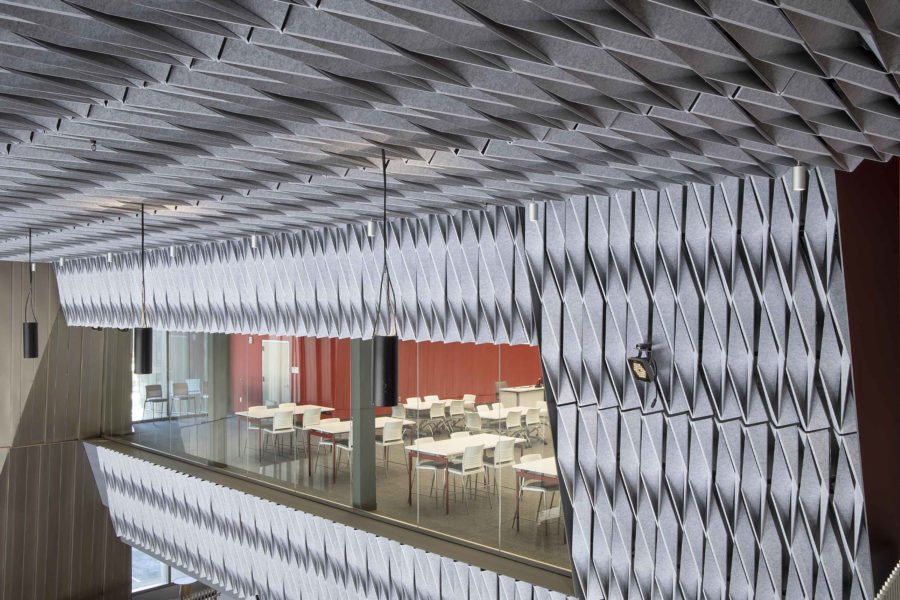
The University of Arizona Health Sciences Innovation Building in Tuscon, Arizona, features a custom acoustic ceiling and wall solution in SoftFold. Photo by Ed Taube
Hopefully, you have begun to understand the calculation process and cautions regarding NRC ratings and how this may affect your space. This understanding should empower you to be efficient with specifications and confident that your spec will perform as required. The NRC rating can help you choose the right material for your job, but only if it is an accurate, true rating. There are three things to consider when you are making a purchasing decision.
First, ask about the NRC rating of multiple products that interest you. The rating should differ from product to product. If it does not, then consider this a caution sign.
Second, ask how your planned installation may change the ratings and discuss your needs with the manufacturer. They should advise you on how the NRC may vary with your installation and make personalized recommendations.
Third, request the laboratory testing report to understand how the product was installed, and to confirm the results match the design and size you are considering.
Lastly, if you feel you are not getting the information you need to make this complex decision. You can always request or engage in third-party testing or work with an acoustician to better understand the truth behind NRC.
Trust in Truth
True NRC was born out of Arktura‘s commitment to transparency, education, and serves as a pledge to provide accuracy and trusted evaluations to our clients. We factor in all considerations and installation arrangements to provide a True NRC rating that accurately reflects our products’ acoustic performance.
You can rest assured that using proper testing methods to evaluate your project will reflect real-life, accurate conditions once installed in your space.
I hope that by sharing this information, you now know what to expect as you approach each specification of your projects. By asking questions, requesting the NRC rating of multiple products for comparison, and by setting clear expectations at the start of a project it will ensure your NRC rating is based on reality.
This article is not intended to portray that True NRC is the only way to discover the accuracy of NRC, but we hope that the diagrams and caution signs help inform you and your teams how to sift through the noise of NRC confusion. As Director of Product Development at Arktura, it is my goal to help architects and designers solve acoustic design problems by providing a clear understanding of our systems’ seamless and cutting-edge technology-driven designs by presenting true NRC testing results informed by real-world conditions.
If you are concerned about NRC accuracy and how it can affect your project, we are always happy to assist, not only with achieving your design intent but also achieving and reaching your space’s specific needs to enhance acoustics and provide the foundation for required sound attenuation that meets the intended NRC rating and, as a result, elevates the overall quality of life, work, wellness, and productivity for those who inhabit any attenuated space.




